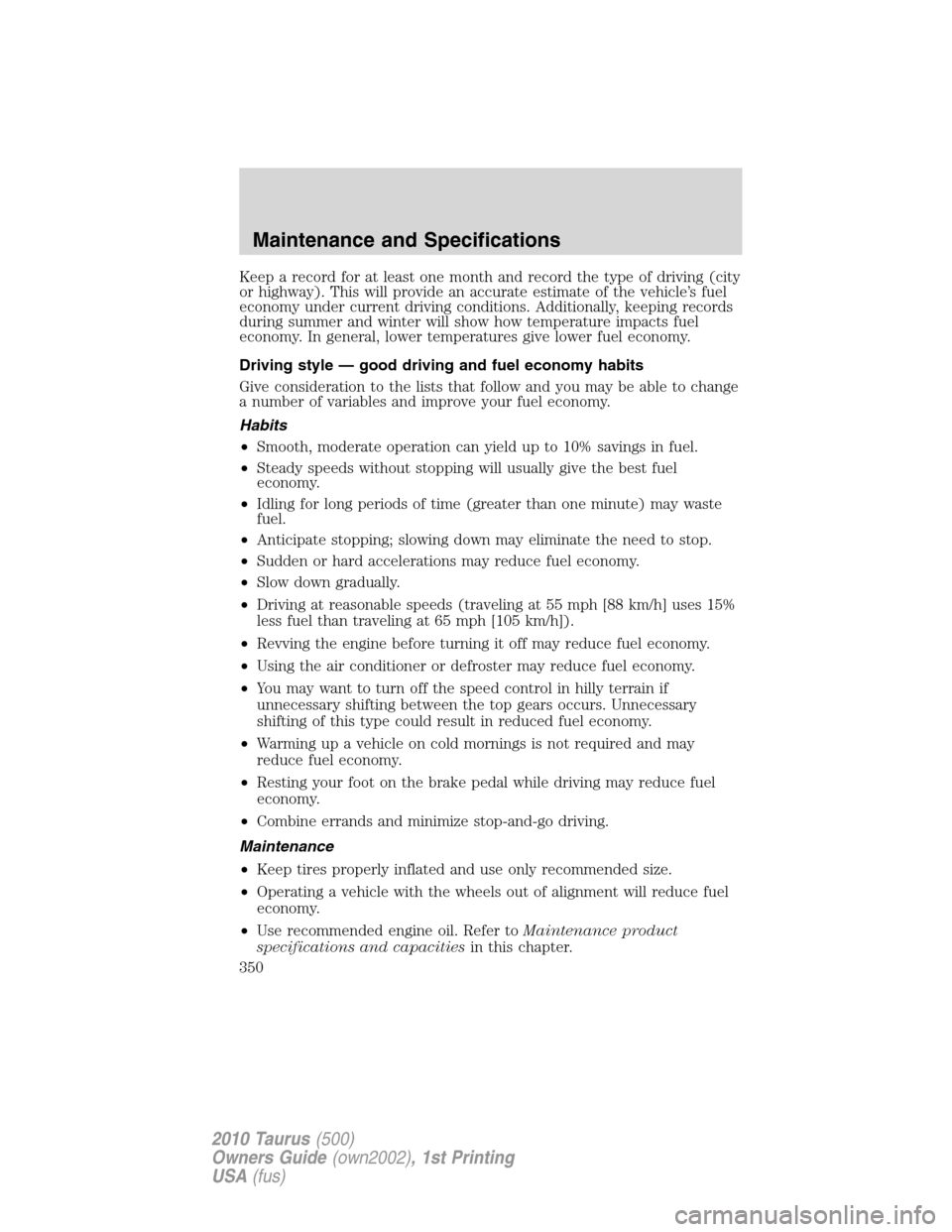Page 290 of 378
Stopping and securing the vehicle
1. Park on a level surface, set the
parking brake and activate hazard
flashers.
2. Place gearshift lever in P (Park)
and turn engine off.
Removing the spare tire and jack
1. Lift the trunk cargo cover, and
remove the wing nut that secures
the spare tire by turning it
counterclockwise.
2. Lift and remove the spare tire
from the trunk.
3. Remove the second wing nut that
secures the jack retention bracket
by turning it counterclockwise,
remove the jack kit from the
vehicle.
4. Remove the jack and the wrench
from the felt bag. Fold down the
wrench socket to use to loosen the
lug nuts and to operate the jack.
Tire change procedure
WARNING:When one of the front wheels is off the ground, the
transmission alone will not prevent the vehicle from moving or
slipping off the jack, even if the vehicle is in P (Park).
Roadside Emergencies
290
2010 Taurus(500)
Owners Guide(own2002), 1st Printing
USA(fus)
Page 291 of 378

WARNING:To help prevent the vehicle from moving when you
change a tire, be sure to place the transmission in P (Park), set
the parking brake and block (in both directions) the wheel that is
diagonally opposite (other side and end of the vehicle) to the tire
being changed.
WARNING:If the vehicle slips off the jack, you or someone else
could be seriously injured.
WARNING:Do not attempt to change a tire on the side of the
vehicle close to moving traffic. Pull far enough off the road to
avoid the danger of being hit when operating the jack or changing the
wheel.
Note:Passengers should not remain in the vehicle when the vehicle is
being jacked.
1. Block the diagonally opposite
wheel.
2. Remove wheel cover (if
equipped) with the lug wrench tip
and loosen each wheel lug nut
one-half turn counterclockwise but
do not remove them until the wheel
is raised off the ground.
WARNING:To lessen the risk of personal injury, do not put any
part of your body under the vehicle while changing a tire. Do not
start the engine when your vehicle is on the jack. The jack is only
meant for changing the tire.
Roadside Emergencies
291
2010 Taurus(500)
Owners Guide(own2002), 1st Printing
USA(fus)
Page 350 of 378

Keep a record for at least one month and record the type of driving (city
or highway). This will provide an accurate estimate of the vehicle’s fuel
economy under current driving conditions. Additionally, keeping records
during summer and winter will show how temperature impacts fuel
economy. In general, lower temperatures give lower fuel economy.
Driving style — good driving and fuel economy habits
Give consideration to the lists that follow and you may be able to change
a number of variables and improve your fuel economy.
Habits
•Smooth, moderate operation can yield up to 10% savings in fuel.
•Steady speeds without stopping will usually give the best fuel
economy.
•Idling for long periods of time (greater than one minute) may waste
fuel.
•Anticipate stopping; slowing down may eliminate the need to stop.
•Sudden or hard accelerations may reduce fuel economy.
•Slow down gradually.
•Driving at reasonable speeds (traveling at 55 mph [88 km/h] uses 15%
less fuel than traveling at 65 mph [105 km/h]).
•Revving the engine before turning it off may reduce fuel economy.
•Using the air conditioner or defroster may reduce fuel economy.
•You may want to turn off the speed control in hilly terrain if
unnecessary shifting between the top gears occurs. Unnecessary
shifting of this type could result in reduced fuel economy.
•Warming up a vehicle on cold mornings is not required and may
reduce fuel economy.
•Resting your foot on the brake pedal while driving may reduce fuel
economy.
•Combine errands and minimize stop-and-go driving.
Maintenance
•Keep tires properly inflated and use only recommended size.
•Operating a vehicle with the wheels out of alignment will reduce fuel
economy.
•Use recommended engine oil. Refer toMaintenance product
specifications and capacitiesin this chapter.
Maintenance and Specifications
350
2010 Taurus(500)
Owners Guide(own2002), 1st Printing
USA(fus)
Page 374 of 378

Emergencies, roadside
jump-starting ..........................304
running out of fuel .........303, 347
Emission control system ..........351
Engine ........................................363
cleaning ...................................320
coolant .....................................336
fail-safe cooling .......................341
idle speed control ...................334
lubrication specifications .......360
refill capacities ........................360
service points ..................328–329
Engine block heater .................240
Engine oil ..................................331
change oil soon warning,
message center .......................331
checking and adding ..............331
dipstick ....................................331
filter, specifications ........333, 359
recommendations ...................333
refill capacities ........................360
specifications ..........................360
Event data recording ....................7
Exhaust fumes ..........................239
F
Fail safe cooling ........................341
Fleet MyKey programming ......134
Fluid capacities .........................360
Four-Wheel Drive vehicles
driving off road .......................270
Fuel ............................................342
calculating fuel
economy ............................21, 348
cap ...........................................344
capacity ...................................360
choosing the right fuel ...........345comparisons with EPA fuel
economy estimates .................351
detergent in fuel .....................346
filler funnel .............................347
filling your vehicle with
fuel ...........................342, 344, 348
filter, specifications ........342, 359
improving fuel economy ........348
octane rating ...................346, 363
quality ......................................346
running out of fuel .........303, 347
safety information relating to
automotive fuels .....................342
Fuses ..........................................279
G
Garage door opener ....................97
Gas cap (see Fuel cap) ............344
Gas mileage
(see Fuel economy) .................348
Gauges .........................................17
H
Hazard flashers .........................278
Headlamps ...................................59
aiming ........................................64
autolamp system .......................59
bulb specifications ....................67
daytime running lights .............63
flash to pass ..............................63
high beam .................................60
replacing bulbs .........................68
turning on and off ....................59
Heating
heating and air conditioning
system ...........................48, 51, 53
Homelink wireless control
system ..........................................98
Index
374
2010 Taurus(500)
Owners Guide(own2002), 1st Printing
USA(fus)